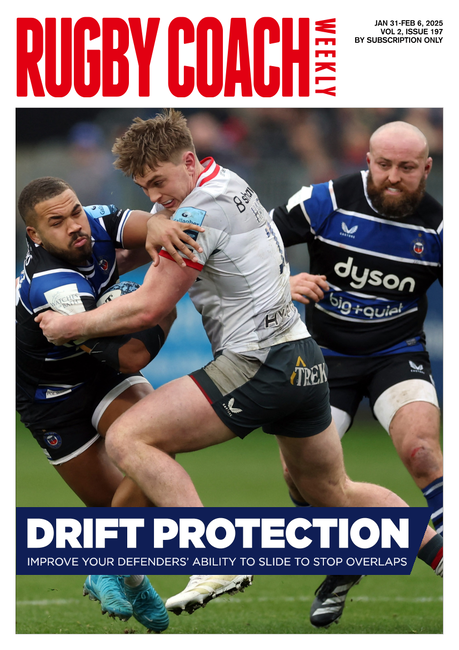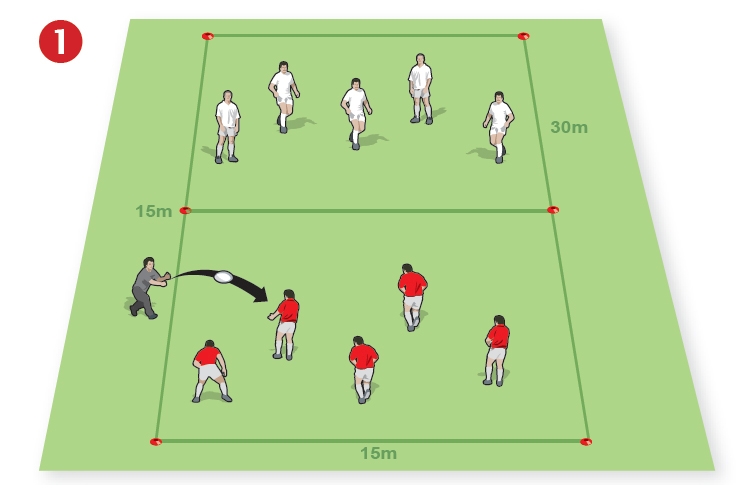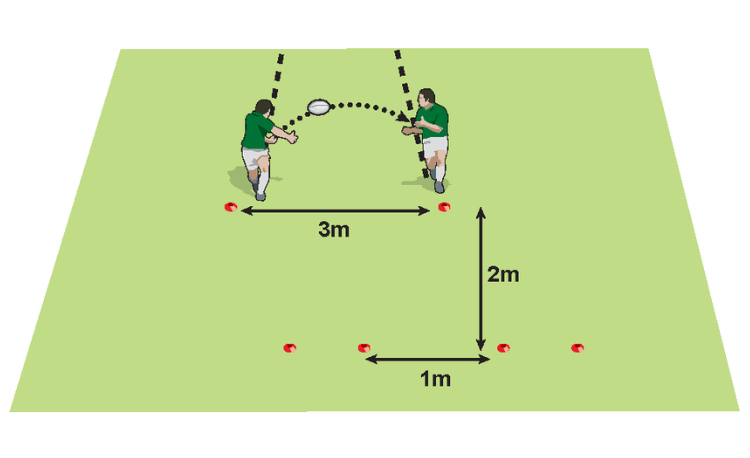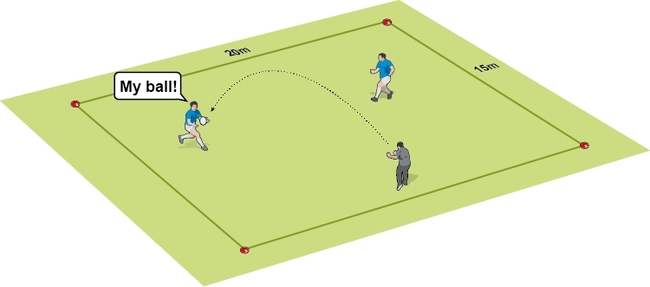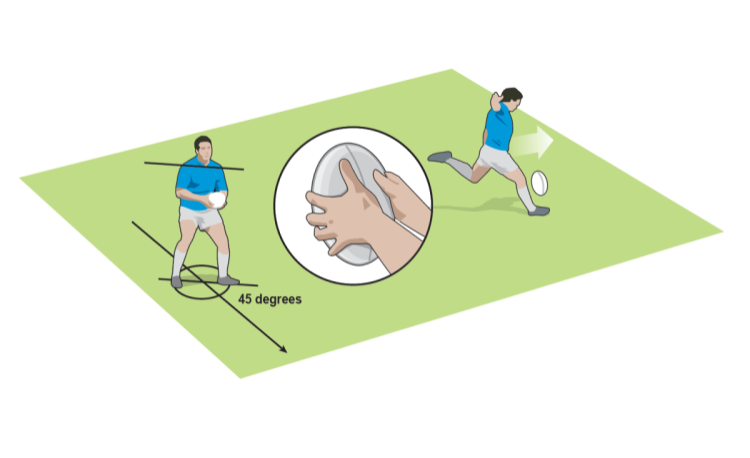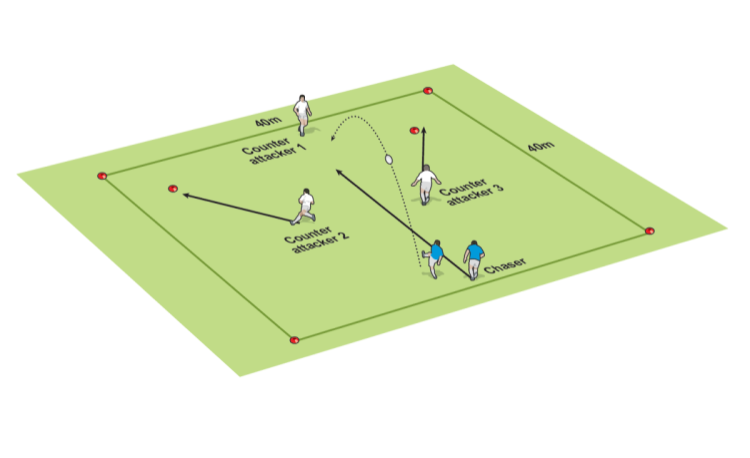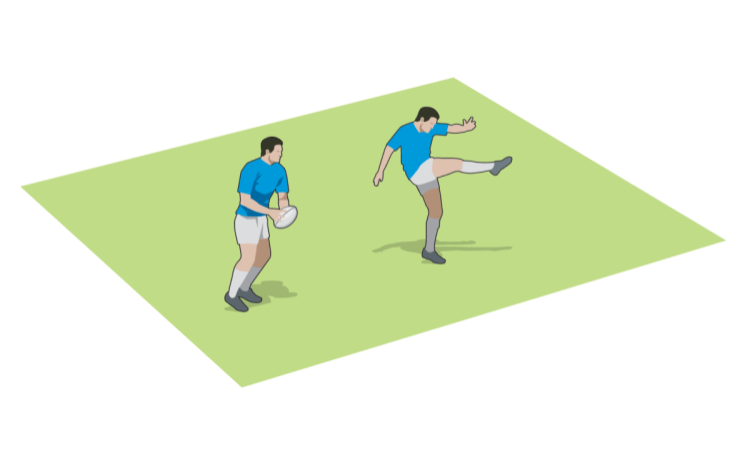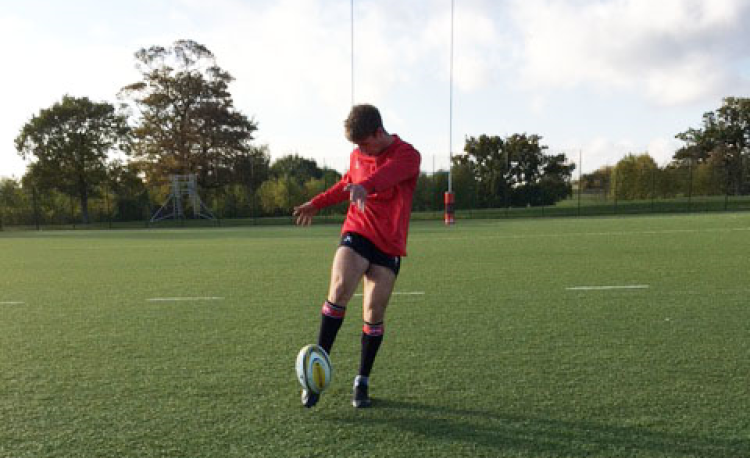Develop kicking game strategies
Kicking & Catchingby Dan Cottrell
Rugby coaching tips
Start by looking at the four main kicking options in attack:
So break down the drill session into two parts. In the first 10 minutes of the drill, concentrate on the kick and chase and the counter attack with a complementary drill. For the next 20 minutes run a scenario of kicking plays with kicks into different parts of the pitch.
Kick and chase drill
The quality of the kick needs to be matched by the quality of the chase if the ball is to be kept infield.
This is a complementary drill session, because players have to both kick and chase, and defend/counter attack. The numbers suggested make up a fifteen man team, so you can rotate players if you have a bigger squad.
Drill set up
This should be an intense drill session. Go through lots of iterations, with only minor interventions to point out different kicks to exploit the strengths of your attack or potential weaknesses in the defence.

Kicking strategy tips
Kicking should have a purpose and not be a last resort. In which case the best way to drill these skills is to put your team on the pitch in various scenarios and get them to work out what to do themselves.
If you only have half-an-hour in which to practise your field kicking, this part of the drill should take up about 20 minutes.
Field kicking drill
You run to various positions on the pitch and indicate the state of the game. The team gets into position and you count down from five. The players have to decide on the kicking strategy they are going to use, then kick (high ball, chip, grubber, for territory).
You repeat the drill in the same place, but now the players have to use an alternative kick. If you have spare players, use them as a back line, filling up the wingers and full back positions first.
Next, gather the players for a quick discussion on the merits of the two kicking options and the execution. But only for a short time. Then move to another position and repeat the drill.
In each drill session look out for the following:
Start by looking at the four main kicking options in attack:
- High ball.
- Cross kick.
- Chip kick.
- Long kick, kicking for territory.
So break down the drill session into two parts. In the first 10 minutes of the drill, concentrate on the kick and chase and the counter attack with a complementary drill. For the next 20 minutes run a scenario of kicking plays with kicks into different parts of the pitch.
Kick and chase drill
The quality of the kick needs to be matched by the quality of the chase if the ball is to be kept infield.
This is a complementary drill session, because players have to both kick and chase, and defend/counter attack. The numbers suggested make up a fifteen man team, so you can rotate players if you have a bigger squad.
Drill set up
- Set up on the half way line, with at least three players forming the back row of a scrum and up to three players opposing them about three metres away if you have spares. Two players act as the scrum halves.
- Three players line up as attacking fly half and centres. Put at least two defenders in front of them. Put three players in the back field to act as defending wings and a full back. Spare players can fill in the other attacking positions.
- The attacking scrum half passes or kicks, or the fly half does the same if he receives the ball. The game is then live as players race back to collect the ball or pressurise the defence. The ball becomes dead if there is a ruck or maul, or if the receiving side cross the halfway line.
This should be an intense drill session. Go through lots of iterations, with only minor interventions to point out different kicks to exploit the strengths of your attack or potential weaknesses in the defence.

Kicking strategy tips
Kicking should have a purpose and not be a last resort. In which case the best way to drill these skills is to put your team on the pitch in various scenarios and get them to work out what to do themselves.
If you only have half-an-hour in which to practise your field kicking, this part of the drill should take up about 20 minutes.
Field kicking drill
You run to various positions on the pitch and indicate the state of the game. The team gets into position and you count down from five. The players have to decide on the kicking strategy they are going to use, then kick (high ball, chip, grubber, for territory).
You repeat the drill in the same place, but now the players have to use an alternative kick. If you have spare players, use them as a back line, filling up the wingers and full back positions first.
Next, gather the players for a quick discussion on the merits of the two kicking options and the execution. But only for a short time. Then move to another position and repeat the drill.
In each drill session look out for the following:
- The reason behind the kick.
- The quality of the chase.
- Which players cover the counter kick or attack.
Newsletter Sign Up
Coaches Testimonials

Gerald Kearney, Downtown Las Vegas Soccer Club

Paul Butler, Florida, USA

Rick Shields, Springboro, USA

Tony Green, Pierrefonds Titans, Quebec, Canada
Subscribe Today
Be a more effective, more successful rugby coach
In a recent survey 89% of subscribers said Rugby Coach Weekly makes them more confident, 91% said Rugby Coach Weekly makes them a more effective coach and 93% said Rugby Coach Weekly makes them more inspired.
Get Weekly Inspiration
All the latest techniques and approaches
Rugby Coach Weekly offers proven and easy to use rugby drills, coaching sessions, practice plans, small-sided games, warm-ups, training tips and advice.
We've been at the cutting edge of rugby coaching since we launched in 2005, creating resources for the grassroots youth coach, following best practice from around the world and insights from the professional game.


